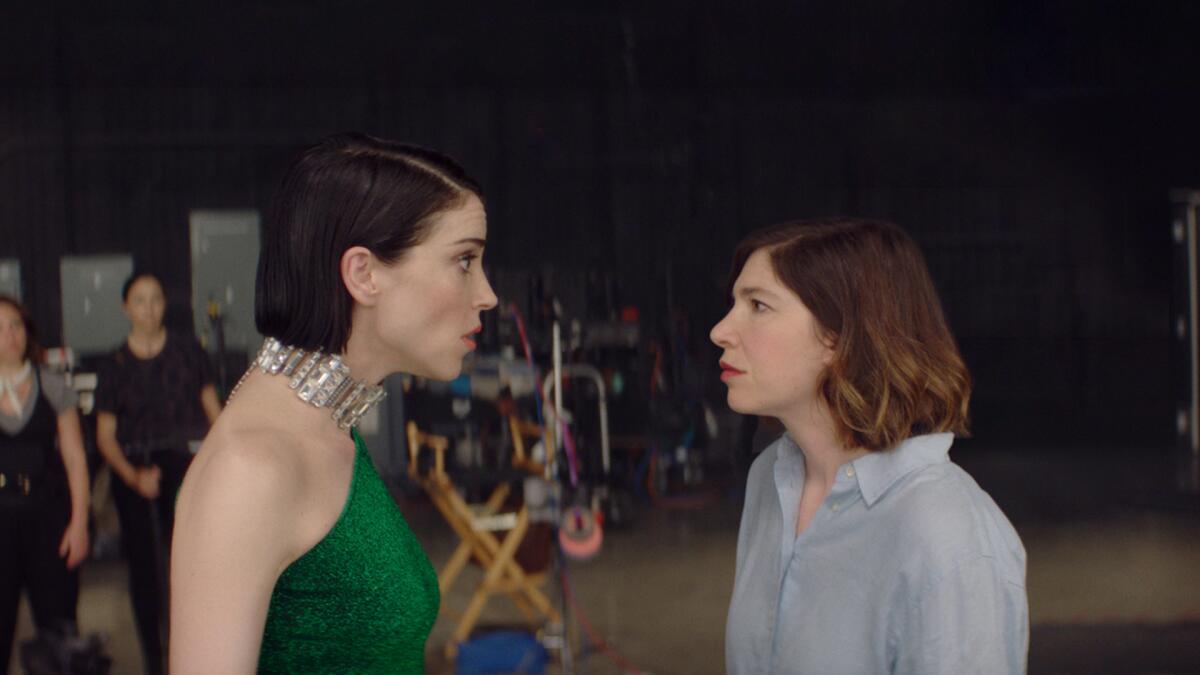Review: Carrie Brownstein and Annie Clark topple St. Vincent in mock doc ‘The Nowhere Inn’

- Share via
The Times is committed to reviewing theatrical film releases during the COVID-19 pandemic. Because moviegoing carries risks during this time, we remind readers to follow health and safety guidelines as outlined by the Centers for Disease Control and Prevention and local health officials.
How many rock stars does it take to make an identity crisis? The meta-fictional mockumentary “The Nowhere Inn” suggests the answer is two. This riff on the conundrum of the stage persona is written by and stars two rock stars: Carrie Brownstein (of Sleater-Kinney) and Annie Clark, a.k.a. St. Vincent, working with director Bill Benz.
For the record:
10:54 a.m. Sept. 17, 2021An earlier version of this review misidentified director Bill Benz.
“The Nowhere Inn” opens with an amusing sketch about the tenuous nature of fame, or lack thereof, featuring Clark riding in a limo while the driver questions who she is, calls his son, and asks her to sing one of her songs. “We’ll find out who you are,” he assures her. This is the prelude to an in media res admission by Clark that a documentary she’s been working on with Brownstein was never completed, because “things went terribly wrong.” “The Nowhere Inn” is the exploration of how this fictional documentary went awry, and why.
This film is essentially a concert doc that uses the genre to toy with notions of self-presentation and the multiple personas of a performer. Layered storytelling that tests the limits of the screen and the fourth wall allows for Clark and Brownstein to play at playing themselves, making for a sharp, comedic commentary on the way fame complicates identity.
The plot concerns a documentary that Brownstein is directing about Clark, a collaboration born out of their close friendship and deep understanding of each other. But Brownstein’s character, or “CB” as she is often called, can’t manage the dissonance between Clark’s two identities. There’s St. Vincent, the sex rock goddess clad in a latex mini-dress, who performs as if one of Robert Palmer’s “Addicted to Love” background dancers stepped to the mic and started shredding. Then there’s Annie, a quietly nerdy music geek who enjoys rousing games of post-show Scrabble, and seems strangely passionate about radish varietals.
CB is a compromised director from the jump, not wanting to exploit Annie’s personal life, but she starts pushing Annie to play the “rock star.” Annie herself is frustrated that no one takes her seriously as Annie, but worships the guitar goddess that is St. Vincent, so she decides to be St. Vincent all the time, adopting an icy cool aloofness, clad in the slick armor of her signature sleek black bob and cat-eye sunglasses.
Featuring the filmmaking apparatus in the film itself and exploring how it interferes in their understanding of each other calls to mind the Agnes Varda nonfiction film about Jane Birkin, “Jane B. par Agnès V.,” in which awareness of the camera and the filmmaking process becomes a way to explore the tension between image-making and the self.
Eventually the film starts to devolve, or rather, evolve into a film about doubles and doppelgangers, entering into the grand canon of films about blurred identities that includes Ingmar Bergman’s “Persona,” Jordan Peele’s “Us” and beyond. Russian literature dictates that doppelgangers can never exist in the same space, and that becomes the tension between Annie and CB, who are continually at odds about what authenticity means.
In between the more cinema vérité moments are flashes of heightened, almost Lynchian horror/thriller aesthetics (David Lynch being known for his own movies about doubles and doppelgangers). These camera movements and stylized lighting and music cues lend a sense of rising tension that’s almost always punctured with a joke.
For a film that gestures at revelation, “The Nowhere Inn” remains a bit arch and removed, an evasive maneuver of sorts. It doesn’t reveal much, but that was never the point. It seems to be an exercise in non-attachment, a warning about the danger of getting too attached to a stage persona, and this seems to be Clark and Brownstein’s way of disrupting the idea of St. Vincent, in a playful and clever way. The most revealing thing Clark admits is that, “all of it’s me and none of it’s me,” and that’s about as close to the truth as we’re going to get.
‘The Nowhere Inn’
Not rated
Running time: 1 hour, 31 minutes
Playing: Starts Sept. 17, Landmark Nuart, West L.A.
More to Read
Only good movies
Get the Indie Focus newsletter, Mark Olsen's weekly guide to the world of cinema.
You may occasionally receive promotional content from the Los Angeles Times.










